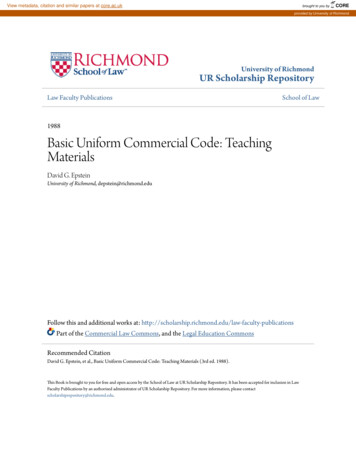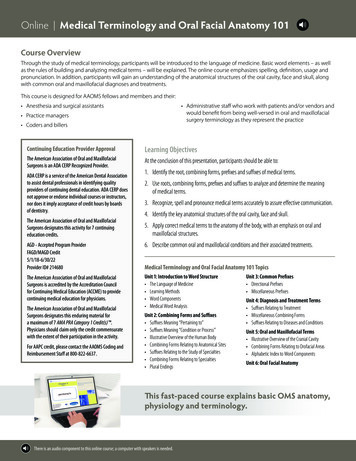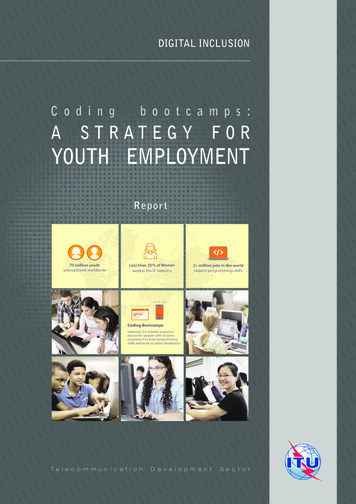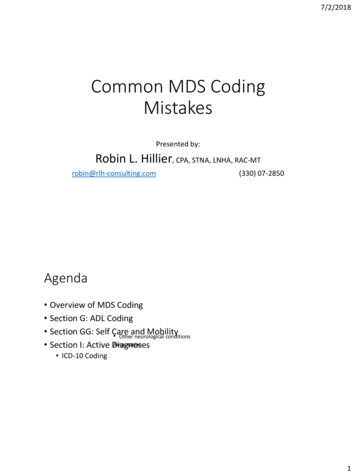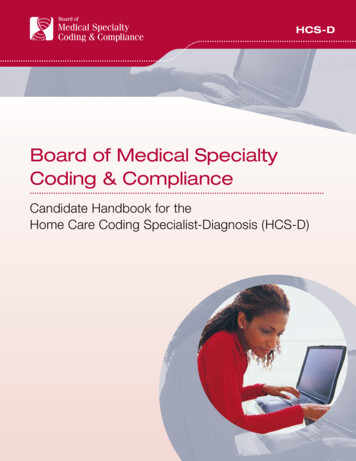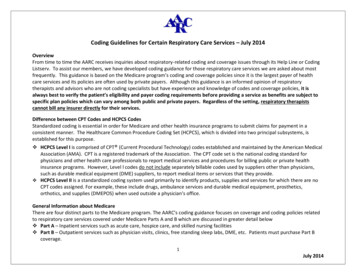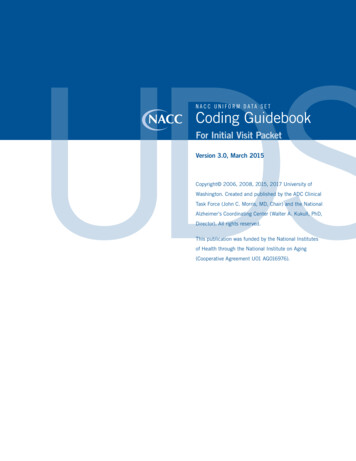
Transcription
NACC UNIFORM DATA SETCoding GuidebookFor Initial Visit PacketVersion 3.0, March 2015Copyright 2006, 2008, 2015, 2017 University ofWashington. Created and published by the ADC ClinicalTask Force (John C. Morris, MD, Chair) and the NationalAlzheimer’s Coordinating Center (Walter A. Kukull, PhD,Director). All rights reserved.This publication was funded by the National Institutesof Health through the National Institute on Aging(Cooperative Agreement U01 AG016976).
Revisions made to this Guidebook since UDS3 implementation (March 15, ion(s) affectedData element(s)affectedbpsys, bpdias2020-10-28New blood pressure guidance provided andnew allowable response addedB132020-08-17Criteria added for MCI with Lewy bodiesD1122019-03-29CDR Dementia Staging Instrument changedto comply with trademarkB4, Z1XN/AN/A2018-08-14Phrase “telephone contact” definedA29bincalls2017-10-05Phrase “MCI due to dementia” corrected to“MCI due to AD.”D111alzdis, alzdisif2017-09-19Instructions on completing Form CLS addedA18hispanic2017-09-19LBD diagnostic criteria updated to reflect 2017guidelines of Dementia With Lewy BodiesConsortiumD14elbdsyn2017-03-14Name of form changed from FunctionalAssessment Questionnaire (FAQ)B7N/AN/A2016-08-12Sample form updated to reflect clarification ofinstructions — administer NPI-Q to all UDSsubjectsB5N/AN/A2016-01-04Reason codes in explanatory text correctedfrom “95–98” to “995–998”C28a, 8btraila, trailb2015-10-29Placement of parentheses changed to clarifyequation used to calculate Total GDS ScoreB616gds2015-10-01Clarification added for subjects with normalcognition and a diagnosis of Parkinson’sdiseaseD112, 12aN/A2015-10-01Explanatory text changed to includeParkinson’s disease only; Lewy body referencedeletedD112bN/A2015-07-29Clarification added for how to answer questionsfor subjects of normal cognition or whosecognition has not yet been evaluatedB5AllAll2015-06-17For Form B5 only, Version 3.1, dated June2015, supplants Version 3.0B5N/AN/A2015-06-17Instructions for Form B5 (NPI-Q) corrected andexpanded to match original instrumentB5AllN/A2015-06-17Text of Form Question 3 changed to make itexplicit that question applies to visual as wellas auditory hallucinations; minor changesmade in explanatory text for other questionsB5Question 3;minor changes to2, 4, 5N/A2017-09-19LBD diagnostic criteria updated to reflect2017 revision by by the Dementia With LewyBodies Consortium.D14eLBDSYNNACC Uniform Data Set (version 3.0, March 2015) CODING GUIDEBOOK for Initial Visit PacketPage 2
Form A1: Subject Demographics1. Primary reason for coming to ADC:1To participate in a research study2To have a clinical evaluation49Both (to participate in a research study and to have a clinicalevaluation)UnknownSelect 1 To participate in a research study if the subject was referred, selected/sampled or recruited, orvolunteered primarily to be part of a research study affiliated with the ADC or to enroll directly as an ADC researchsubject.Select 2 To have a clinical evaluation if the subject was referred by family, friend, self, physician, health careworker, employer, or concerned citizen for a medical assessment because of concerns about the subject’s health,cognition, behavior, movements, etc.Select 4 Both if the subject was referred to participate in a research study and for a clinical evaluation.Select 9 Unknown only if the subject and/or co-participant is unable or unwilling to provide information thatwould allow a more specific response.2a. Principal referral source:(If answer is 1 or 2, CONTINUE TO QUESTION 2B; otherwise,SKIP TO QUESTION 3.)12Self-referralNon-professional contact (spouse/partner, relative, friend,coworker, etc.)3ADC participant referral4ADC clinician, staff, or investigator referral5Nurse, doctor, or other health-care provider6Other research study clinician/staff/investigator (non-ADC;e.g., ADNI, Women’s Health Initiative)8Other9UnknownSelect 1 Self-referral if the subject decided to enroll in the ADC on his/her own initiative (e.g., after seeing anadvertisement, media appeal, website, news article, or learning about the ADC’s research through a communityevent).Select 2 Non-professional contact if the subject learned about the ADC through his/her spouse or partner,relative, friend, coworker, or other non-professional contact.Select 3 ADC participant referral if the subject learned about the ADC through another ADC participant.Select 4 ADC clinician, staff, or health care provider if the subject learned about the ADC through someonewho works in the ADC.Select 5 Nurse, doctor, or health-care provider if the subject learned about the ADC through his/her nurse,doctor, or other health-care provider (i.e., primary care or other non-ADC provider).Select 6 Other research study clinician/staff/investigator if the subject learned about the ADC throughparticipation in another research study (e.g., Women’s Health Initiative (WHI), ADNI).Select 8 Other if the subject learned of the ADC through someone else not covered in options 1 through 6 above.Select 9 Unknown only if the subject and/or co-participant is unable or unwilling to provide information thatwould allow a more specific response.NACC Uniform Data Set (version 3.0, March 2015) CODING GUIDEBOOK for Initial Visit PacketPage 1
2b. If the referral source was self-referral or a nonprofessional contact, how did the referral sourcelearn of the ADC?1234ADC advertisement (e.g., website, mailing, newspaper ad,community presentation)News article or TV program mentioning the ADC studyConference or community event (e.g., community memorywalk)Another organization’s media appeal or website (e.g.,Alzheimer’s Association, clinicaltrials.gov)8Other9UnknownSelect 1 ADC advertisement if the referral source learned of the ADC through an ADC-specific advertisement, suchas the ADC’s website, a mailing, a newspaper ad, or a community presentation.Select 2 News article or TV program if the referral source learned of the ADC through a news article or TVprogram.Select 3 Conference or community event if the referral source learned of the ADC through a community eventor conference such as a memory walk.Select 4 Another organization’s media appeal or website if the referral source learned of the ADC throughanother organization’s advertisement (e.g., Alzheimer’s Association), such as a website or media appeal.Select 8 Other if the referral source learned of the ADC through another source of information not covered inoptions 1 through 4 above.Select 9 Unknown only if the subject/informant is unable or unwilling to provide information that would allow amore specific response.3. Presumed disease status at enrollment:1Case, patient, or proband2Control or normal3No presumed disease statusThis question refers to what the assessment staff presumes the disease status to be at enrollment into the UDS(regardless of whether there were previous non-UDS assessments at the Center).Select 1 Case, patient, or proband if the subject is a patient/proband at the Center, or is presumed to havedementia or MCI at the UDS initial visit.Select 2 Control or normal if the subject was enrolled because s/he was thought to be cognitively intact (e.g., forcomparison with impaired patients), regardless of the eventual outcome of subsequent evaluation.Select 3 No presumed disease status if the subject was enrolled and it wasn’t yet determined whether s/he wasthought to be a case or control (e.g., for population screening).4. Presumed participation:1Initial evaluation only2Longitudinal follow-up plannedSelect 1 Initial evaluation only if the subject was enrolled for a one-time evaluation, with no subsequent follow-upvisits planned.Select 2 Longitudinal follow-up planned if the subject was enrolled with the intent that s/he would make one ormore additional visits after completing an initial evaluation.NACC Uniform Data Set (version 3.0, March 2015) CODING GUIDEBOOK for Initial Visit PacketPage 2
5. ADC enrollment type:12Primarily ADC-funded (Clinical Core, Satellite Core, or otherADC Core or project)Subject is supported primarily by a non-ADC study (e.g.,R01, including non-ADC grants supporting FTLD Moduleparticipation)Select 1 Primarily ADC-funded if the subject’s enrollment and follow-up are funded primarily by the ADC grant(e.g., Clinical Core, Satellite Core, or other ADC Core or project).Select 2 Subject is supported primarily by a non-ADC study if the subject is primarily enrolled in, orsupported by, a non-ADC study (e.g., an R01, a non-ADC grant supporting FTLD Module participation, etc.).6. Subject’s month and year of birth (MM / YYYY):/Based on the best available information from the subject (or co-participant, if necessary), enter the subject’s monthand year of birth in the specified numerical format (e.g., March 1920 would be entered as “03/1920”).7. Subject’s sex:8. Does the subject report being of Hispanic/Latinoethnicity (i.e., having origins from a mainlySpanish-speaking Latin American country),regardless of race?1Male2Female0No (If No,1Yes9Unknown (If Unknown,SKIP TO QUESTION 9)SKIP TO QUESTION 9)Ask the subject (or co-participant, if necessary) whether the subject considers her/his ethnicity to be Hispanic/Latino.If the subject or co-participant indicates that the subject is Hispanic/Latino (1 Yes), complete the Linguistic HistoryForm (Form CLS).Form CLS must be completed and submitted to NACC only ONCE. It may be completed along with any UDSInitial or Follow-up visit. Information to complete CLS may be obtained from the subject or a co-participant.8a.If yes, what are the subject’s reportedorigins?1234565099Mexican, Chicano, or Mexican-AmericanPuerto RicanCubanDominicanCentral AmericanSouth AmericanOther (SPECIFY) :UnknownAsk the subject (or co-participant, if necessary) what s/he considers the subject’s Hispanic origins to be. Read or showthe choices, if required, and allow only one category choice.Select number 1 if the subject reports having origins in Mexico.Select number 2 if the subject reports having origins in Puerto Rico.Select number 3 if the subject reports having origins in Cuba.Select number 4 if the subject reports having origins in the Dominican Republic.Select number 5 if the subject reports having origins in Belize, Costa Rica, El Salvador, Guatemala, Honduras,Nicaragua, or Panama.Select number 6 if the subject reports having origins in Argentina, Bolivia, Chile, Colombia, Ecuador, Paraguay,Peru, Uruguay, or Venezuela.Select number 50 if the subject reports origins other than those listed in options 1 through 6 above, and enter theorigin in the space provided.Select number 99 only if the subject or co-participant is unable or unwilling to identify the subject’s origins.NACC Uniform Data Set (version 3.0, March 2015) CODING GUIDEBOOK for Initial Visit PacketPage 3
9. What does the subject report as his orher race?1White2Black or African American3American Indian or Alaska Native4Native Hawaiian or other Pacific Islander5Asian50Other99Unknown(SPECIFY) :Ask the subject (or, if necessary, the co-participant) what s/he considers the subject’s race to be. NIH defines raceand Hispanic ethnicity separately; therefore, please do not enter “Hispanic” or the subject’s specific Hispanic origins(e.g., Mexico) as the subject’s race. Instead, be sure to indicate Hispanic ethnicity in Question 8. If the subject will notidentify a race and identifies only as Hispanic, select 99 Unknown. Read or show the choices, and allow only onecategory choice. There will be an opportunity to record other applicable race categories in Questions 10 and 11.4 Native Hawaiian or other Pacific Islander includes Native Hawaiian, Guamanian or Chamorro, Samoan, orother Pacific Islander.5 Asian includes Asian Indian, Chinese, Filipino, Japanese, Korean, Vietnamese, or other Asian.If you select 50 Other, specify if the subject reports a race other than those listed above, and enter the race in thespace provided. If the subject prefers to report her/his race as multiracial, select 50 Other (specify), and specify“multiracial”.Select 99 Unknown only if the subject or co-participant is unable or unwilling to identify the subject’s race.10. What additional race does the subject report?1White2Black or African American3American Indian or Alaska Native4Native Hawaiian or other Pacific Islander5Asian50Other88None reported99Unknown(SPECIFY) :If the subject or co-participant reports an additional race for the subject, select the box that corresponds to thisadditional race. Do not record a race that was already provided in Question 9.4 Native Hawaiian or other Pacific Islander and 5 Asian: See previous inclusion list (Question 9).Select 50 Other (specify) if the subject or co-participant reports an additional race other than those listed inoptions 1 through 5, and enter the race in the space provided.Select 88 None reported if the subject or co-participant reports no additional race for the subject beyond what wasreported in Question 9.Select 99 Unknown if the subject or co-participant reports the subject as having an additional race but is unable orunwilling to identify it.NACC Uniform Data Set (version 3.0, March 2015) CODING GUIDEBOOK for Initial Visit PacketPage 4
11. What additional race, beyond those reported inQuestions 9 and 10, does the subject report?1White2Black or African American3American Indian or Alaska Native4Native Hawaiian or other Pacific Islander5Asian50Other88None reported99Unknown(SPECIFY) :If the subject or co-participant reports an additional race for the subject, check the box that corresponds to thisadditional race. Do not record a race that was already provided in Questions 9 and 10.4 Native Hawaiian or other Pacific Islander and 5 Asian: See previous inclusion list (Questions 9 and 10).Select 50 Other (specify) if the subject or co-participant reports an additional race other than those listed inoptions 1 through 5, and enter the race in the space provided.Select 88 None reported if the subject or co-participant reports no additional race for the subject beyond what wasrecorded in Questions 9 and 10.Select 99 Unknown if the subject or co-participant reports the subject as having an additional race but is unable orunwilling to identify it.12. Subject’s primary an6Japanese8Other primary language9Unknown(SPECIFY) :Record the language that the subject (or co-participant) considers to be the subject’s main language — i.e., thelanguage that s/he speaks and writes best.Select 8 Other primary language (specify) if the subject or co-participant reports a primary language other thanthose described, and enter the language in the space provided.Select 9 Unknown only if the subject or co-participant is unable or unwilling to identify the subject’s primarylanguage.NACC Uniform Data Set (version 3.0, March 2015) CODING GUIDEBOOK for Initial Visit PacketPage 5
13. Subject’s years of education — use the codes below to report the level achieved; ifan attempted level is not completed, enter the number of years completed:12 high school or GED 16 bachelor’s degree 18 master’s degree 20 doctorate99 unknownThis question refers to achieved educational levels, rather than the number of years it took to complete that level.Use the following to describe achieved educational levels: High school or GED 12 years, bachelor’s degree 16 years,master’s degree 18 years, doctorate 20 years.If the subject has not completed a level, enter the total number of years of education completed toward that level.Examples: If the subject attended school for eight years and did not earn a diploma or GED, enter “08”. If the subjectcompleted 17.5 years of school and earned a bachelor’s degree but did not complete an attempted master’s degree,enter “17”. (However, if the subject attended school for 17.5 years to earn a bachelor’s degree and that was theintended level of achievement, then enter “16”.) If the subject attended school for 25 years to earn a PhD, enter “20” toindicate the achieved educational level.If the subject or co-participant is unable or unwilling to answer the question, enter “99”.14. Subject’s current marital status:1Married2Widowed3Divorced4Separated5Never married (or marriage was annulled)6Living as married / domestic partner9UnknownSelect the box for the category that most accurately describes the subject’s current marital status.6 Living as married may be applied to either heterosexual or same-sex relationships.Select 9 Unknown only if the subject or co-participant is unable or unwilling to identify the subject’s marital status.15. What is the subject’s living situation?1Lives alone2Lives with one other person: a spouse or partner3Lives with one other person: a relative, friend, or roommate4569Lives with caregiver who is not spouse/partner, relative,or friendLives with a group (related or not related) in a private residenceLives in group home (e.g., assisted living, nursing home,convent)UnknownSelect the box for the category most accurately describes the subject’s current living situation.Select 9 Unknown only if the subject or co-participant is unable or unwilling to identify the subject’s livingsituation.NACC Uniform Data Set (version 3.0, March 2015) CODING GUIDEBOOK for Initial Visit PacketPage 6
16. What is the subject’s level of independence?1Able to live independently2Requires some assistance with complex activities3Requires some assistance with basic activities4Completely dependent9UnknownSelect the box for the category that most accurately describes the level of activity the subject is able to do. If thesubject or co-participant indicates that the subject is able to perform complex activities but is not doing the activitiesbecause of her/his living situation, the subject is still considered to be able to live independently.Select 2 Requires some assistance with complex activities if subject has deterioration in accustomedcomplex abilities (e.g., paying bills, shopping, remembering appointments, driving, cooking).Select 3 Requires some assistance with basic activities if subject has deterioration in accustomed basicabilities (e.g., eating, dressing, personal hygiene).Select 4 Completely dependent if subject is unable to perform basic activities of daily living.Select 9 Unknown only if the subject or co-participant is unable or unwilling to identify the subject’s livingsituation.17. What is the subject’s primary type of residence?1Single- or multi-family private residence (apartment, condo,house)2Retirement community or independent group living3Assisted living, adult family home, or boarding home4Skilled nursing facility, nursing home, hospital, or hospice9UnknownSelect the box for the category that most accurately describes the subject’s type of residence.Select 9 Unknown only if the subject or co-participant is unable or unwilling to identify the subject’s current typeof residence.18. ZIP Code (first three digits) of subject’s primary residence:(If unknown, leave blank)Provide the first three digits of the subject’s ZIP Code. If the ZIP Code is unknown, leave the field blank.19. Is the subject left- or right-handed (for example,which hand would s/he normally use to write orthrow a wnSelect the box for the category that reflects the hand(s) used most predominantly by the subject, as indicated by thesubject or co-participant.Select 9 Unknown only if the subject or co-participant is unable or unwilling to identify the subject’s handedness.NACC Uniform Data Set (version 3.0, March 2015) CODING GUIDEBOOK for Initial Visit PacketPage 7
SAMPLE FORMPage 8
SAMPLE FORMPage 9
SAMPLE FORMPage 10
Form A2: Co-participant Demographics1. Co-participant’s month and year of birth (MM / YYYY):(99/9999 unknown)/Enter the co-participant’s month and year of birth in the specified numerical format (e.g., March 1920 would beentered as “03/1920”). If the co-participant is unable or unwilling to answer, enter “99/9999”.2. Co-participant’s sex:3. Does the co-participant report being of Hispanic/Latinoethnicity (i.e., having origins from a mainly Spanishspeaking Latin American country), regardless of race?1Male2Female0No (If No, SKIP TO QUESTION 4)1Yes9Unknown (If Unknown, SKIP TO QUESTION 4)Ask the co-participant whether s/he considers her/his ethnicity to be Hispanic/Latino.3a. If yes, what are the co-participant’s reported origins?1Mexican, Chicano, or Mexican-American2Puerto Rican3Cuban4Dominican5Central American6South American50Other99Unknown(SPECIFY) :Ask the co-participant what s/he considers his/her Hispanic origins to be. Read or show the choices, if required, andallow only one category choice.Select 1 Mexican, Chicano, or Mexican-American if the co-participant reports having origins in Mexico.Select 2 Puerto Rican if the co-participant reports having origins in Puerto Rico.Select 3 Cuban if the co-participant reports having origins in Cuba.Select 4 Dominican if the co-participant reports having origins in the Dominican Republic.Select 5 Central American if the co-participant reports having origins in Belize, Costa Rica, El Salvador,Guatemala, Honduras, Nicaragua, or Panama.Select 6 South American if the co-participant reports having origins in Argentina, Bolivia, Chile, Colombia,Ecuador, Paraguay, Peru, Uruguay, or Venezuela.Select 50 Other (specify) if the co-participant reports origins other than those listed in options 1 through 6 above,and enter the origin in the space provided.Select 99 Unknown only if the co-participant is unable or unwilling to identify the subject’s origins.NACC Uniform Data Set (version 3.0, March 2015) CODING GUIDEBOOK for Initial Visit PacketPage 11
4. What does the co-participant report as his or her race?1White2Black or African American3American Indian or Alaska Native4Native Hawaiian or other Pacific Islander5Asian50Other99Unknown(SPECIFY) :Ask the co-participant what s/he considers her/his race to be. NIH defines race and Hispanic ethnicity separately;therefore, please do not write in “Hispanic” or the specific Hispanic origins (e.g., Mexico) as the co-participant’srace. Instead, be sure to indicate Hispanic ethnicity in Question 3. If the co-participant will not identify a race andidentifies only as Hispanic, select 99 Unknown. Read or show the choices, and allow only one category choice.There will be an opportunity to record other applicable race categories in Questions 5 and 6.4 Native Hawaiian or Other Pacific Islander: This includes Native Hawaiian, Guamanian or Chamorro,Samoan, or other Pacific Islander.5 Asian: This includes Asian Indian, Chinese, Filipino, Japanese, Korean, Vietnamese, or other Asian.Select 50 Other (specify) if the co-participant reports a race other than those listed, and enter the race in thespace provided. If the co-participant prefers to report her/his race as multiracial, select 50 Other (specify) andspecify “multiracial”.Select 99 Unknown only if the co-participant is unable or unwilling to identify her/his race.5. What additional race does the co-participant report?1White2Black or African American3American Indian or Alaska Native4Native Hawaiian or other Pacific Islander5Asian50Other88None reported99Unknown(SPECIFY) :If the co-participant reports an additional race, select the box that corresponds to this additional race. Do not recorda race that was already provided in Question 4.4 Native Hawaiian or Other Pacific Islander and 5 Asian: See previous inclusion list (Question 4).Select 50 Other (specify) if the co-participant reports an additional race other than those listed in options 1through 5, and enter the race in the space provided.Select 88 None reported if the co-participant reports no additional race beyond what was reported inQuestion 4.Select 99 Unknown if the co-participant reports having an additional race but is unable or unwilling toidentify it.NACC Uniform Data Set (version 3.0, March 2015) CODING GUIDEBOOK for Initial Visit PacketPage 12
6. What additional race, beyond those reported in Questions4 and 5, does the co-participant report?1White2Black or African American3American Indian or Alaska Native4Native Hawaiian or other Pacific Islander5Asian50Other88None reported99Unknown(SPECIFY) :If the co-participant reports an additional race, select the box that corresponds to this additional race. Do not recorda race that was already provided in Questions 4 and 5.4 Native Hawaiian or Other Pacific Islander and 5 Asian: See previous inclusion list (Questions 4 and 5).Select 50 Other (specify) if the co-participant reports an additional race other than those listed in options 1through 5, and enter the race in the space provided.Select 88 None reported if the co-participant reports no additional race beyond what was recorded in Questions 4and 5.Select 99 Unknown if the co-participant reports an additional race but is unable or unwilling to identify it.7. Co-participant’s years of education — use the codes below to report the level achieved; if anattempted level is not completed, enter the number of years completed:12 high school or GED16 bachelor’s degree18 master’s degree20 doctorate99 unknownThis question refers to achieved educational levels, rather than the number of years it took to complete that level.Use the following to describe achieved educational levels: High school or GED 12 years, bachelor’s degree 16 years,master’s degree 18 years, doctorate 20 years.If the co-participant hasn’t completed a level, enter the total number of years of education completed toward thatlevel.Examples: If the co-participant attended school for eight years and did not earn a diploma or GED, enter “08”. Ifthe co-participant completed 17.5 years of school and earned a bachelor’s degree but did not complete an attemptedmaster’s degree, enter “17”. (However, if the co-participant attended school for 17.5 years to earn a bachelor’s degreeand that was the intended level of achievement, then enter “16”.) If the co-participant attended school for 25 years toearn a doctorate degree, enter “20” to indicate the achieved educational level.If the co-participant is unable or unwilling to answer the question, enter “99”.8. What is co-participant’s relationship to the subject?1Spouse, partner, or companion (include ex-spouse,ex-partner, fiancé(e), boyfriend, girlfriend)2Child (by blood or through marriage or adoption)3Sibling (by blood or through marriage or adoption)456Other relative (by blood or through marriage oradoption)Friend, neighbor, or someone known through family,friends, work, or community (e.g., church)Paid caregiver, health care provider, or clinicianNACC Uniform Data Set (version 3.0, March 2015) CODING GUIDEBOOK for Initial Visit PacketPage 13
8a. How long has the co-participant known the subject?years (999 unknown)If the exact number of years is unknown, ask the co-participant to estimate it. If the co-participant is not able toestimate the number of years he/she has known the subject, enter 999 Unknown.9. Does the co-participant live with the subject?0No1Yes (If Yes, SKIP TO QUESTION 10)Select 1 Yes if the co-participant currently lives with the subject at least part of the time.9a. If no, approximate frequency of in-person visits?9b. If no, approximate frequency of telephone contact?1Daily2At least three times per week3Weekly4At least three times per month5Monthly6Less than once a month1Daily2At least three times per week3Weekly4At least three times per month5Monthly6Less than once a month“Telephone contact” includes by communcating by phone, video messaging applications, and text/messagingapplications.10. Is there a question about the co-participant’s reliability?0No1YesThe co-participant’s reliability should be based on a consensus opinion from the staff that interacted with the coparticipant. This question would best be filled out after the UDS assessments have been completed, when a betterjudgment can be made about the co-participant’s reliability. If there is any reason to doubt the reliability of the coparticipant, select 1 Yes.NACC Uniform Data Set (version 3.0, March 2015) CODING GUIDEBOOK for Initial Visit PacketPage 14
SAMPLE FORMPage 15
SAMPLE FORMPage 16
Form A3: Subject Family History1. Are there affected first-order relatives (biological parents, fullsiblings, or biological children)?“Affected” having dementia or one of the non-normaldiagnoses listed in Appendix 1 on page 50No1Yes9UnknownSelect 1 Yes if there are biological parents, full siblings, or biological children who are affected by dementia or haveone of the non-normal diagnoses listed in Appendix 1 on page 5 of this form.2a. In this family, is there evidence for an AD mutation? If Yes,select predominant mutation.NOTE: APOE should not be reported here.0No (SKIP TO QUESTION 3a)1Yes, APP2Yes, PS-1 (PSEN-1)3Yes, PS-2 (PSEN-2)8Yes, Other9Unknown whether mutation exists (SKIP TOQUESTION 3a)(SPECIFY) :If there is any evidence for an AD mutation in any of the subject’s blood relatives, indicate the predominant mutation,otherwise select 0 No. Although blood relatives might have evidence for more than one genetic mutation, indicate thepredominant mutation only. Evidence may be provided via family report, test, or other report or documentation.Select 9 Unknown whether mutation exists if it is unknown whether there is an AD mutation.If an AD mutation is known to exist in the subject’s family, but the type of mutation is unknown, select 8 Yes, Other(specify) and enter “Unknown” on the specify line.Do not include APOE e4 carrier status.2b. Source of evidence for AD mutation (check one):1Family report (no test documentation available)2Commercial test documentation3Research lab test documentation8Other (SPECIFY):9UnknownNACC Uniform Data Set (version 3.
NACC Uniform Data Set (version 3.0, March 2015) CODING GUIDEBOOK for Initial Visit Packet Page 2 Revisions made to this Guidebook since UDS3 implementation (March 15, 2015) Date yyyy-mm-dd Description Form(s) affected Question(s) affected Data element(s) affected 2020-10-28 New blood pressure guidance provided and new allowable response added

